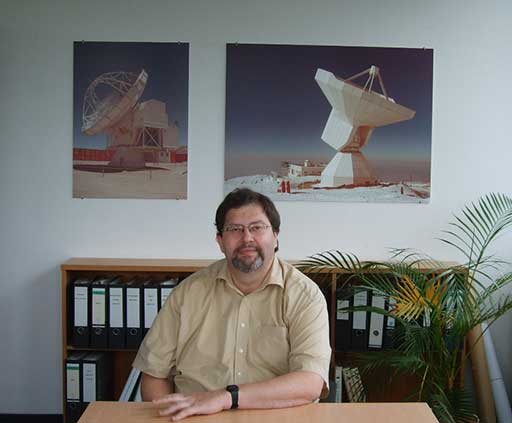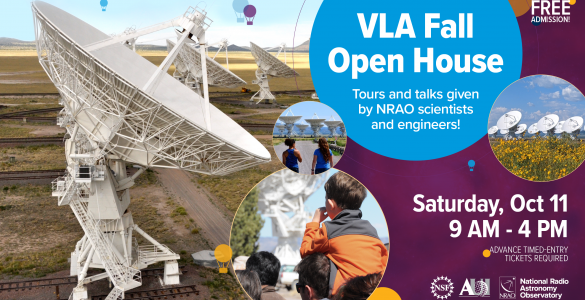Associated Universities, Inc., (AUI) and the National Radio Astronomy Observatory (NRAO) have awarded the 2007 Karl G. Jansky Lectureship to Professor Karl M. Menten of the Max-Planck-Institute for Radioastronomy in Bonn, Germany. The Jansky Lectureship is an honor established by the trustees of AUI to recognize outstanding contributions to the advancement of astronomy.
Professor Menten is an extraordinarily productive scientist whose research has improved our fundamental understanding in a number of areas of astronomy. He has studied the chemistry of molecular clouds from which new stars are formed, the process of star formation in our own Milky Way Galaxy and in the early Universe, and the outer atmospheres of stars nearing the end of their “normal” lives.
In 1991, Menten used NRAO’s 140-foot Telescope at Green Bank, West Virginia, to discover strong radio emission from methanol masers in star-forming regions. These masers amplify, or strengthen, radio emission the same way a laser amplifies visible-light emission. Menten developed the observation of these methanol masers into a powerful tool for studying the formation of stars much more massive than our Sun, because the strong maser emission points astronomers to the stellar birthplaces. In addition, Menten pioneered the use of ultra-high-resolution observations with NRAO’s Very Long Baseline Array to observe masers to make precision determinations of the structure, size and dynamics of the Milky Way.
Menten received his doctoral degree in 1987 from the University of Bonn, Germany. He then joined the Harvard-Smithsonian Center for Astrophysics, working there until 1996, when he became the Director for Millimeter and Submillimeter Astronomy at the Max-Planck-Institute for Radioastronomy. In addition to that position, he also has been a Professor for Experimental Astrophysics at the University of Bonn since 2001. He initiated the Atacama Pathfinder Experiment (APEX), a 12-meter diameter telescope high in Chile’s Atacama Desert, where the Atacama Large Millimeter/submillimeter Array (ALMA) is being built. APEX pioneered submillimeter-wavelength observations at Atacama, proving the quality of the site for such research.
As Jansky Lecturer, Menten will give a presentation entitled, “Tuning in to the Molecular Universe,” at NRAO facilities in Charlottesville, Virginia, Green Bank, West Virginia, and Socorro, New Mexico. The dates of these lectures, which are free and open to the public, will be announced later this summer.
This is the forty-second Jansky Lectureship. First awarded in 1966, it is named in honor of the man who, in 1932, first detected radio waves from a cosmic source. Karl Jansky’s discovery of radio waves from the central region of the Milky Way started the science of radio astronomy. Other recipients of the Jansky award include five Nobel laureates (Drs. Subrahmanyan Chandrasekhar, Arno Penzias, Robert Wilson, William Fowler, and Joseph Taylor) as well as Jocelyn Bell-Burnell, discoverer of the first pulsar, and Vera Rubin, discoverer of dark matter in galaxies.
The National Radio Astronomy Observatory is a facility of the National Science Foundation, operated under cooperative agreement by Associated Universities, Inc.











